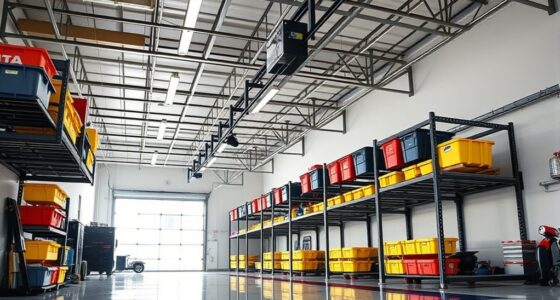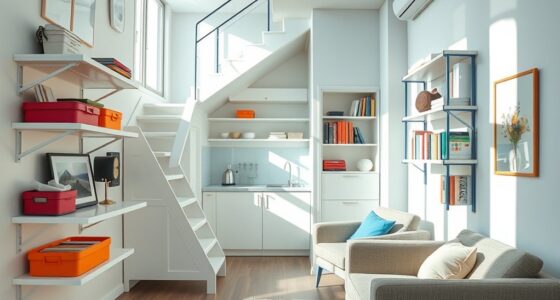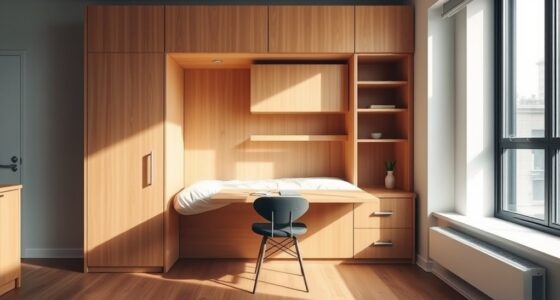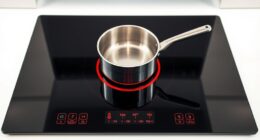Stop overusing clear storage bins, filling shelves to capacity, stacking items without easy access, and using the same containers for everything. These habits waste space and make organizing harder. Instead, use bins selectively, leave space on shelves, keep items accessible, and choose containers suited for your items. Don’t ignore vertical space either—install hooks or shelves. If you stay mindful of these tips, you’ll create more efficient, clutter-free storage areas. Keep going to learn smarter ways to organize better.
Key Takeaways
- Overusing transparent storage bins creates labeling clutter and wastes space with unnecessary gaps.
- Filling shelves to capacity makes items hard to access and risks damage, reducing effective storage.
- Stacking items too high or deep hampers accessibility and increases the chance of damage.
- Using uniform containers for everything can lead to confusion and inefficient use of space.
- Ignoring vertical space and wall storage wastes valuable room that could improve organization.
Overusing Clear Storage Bins
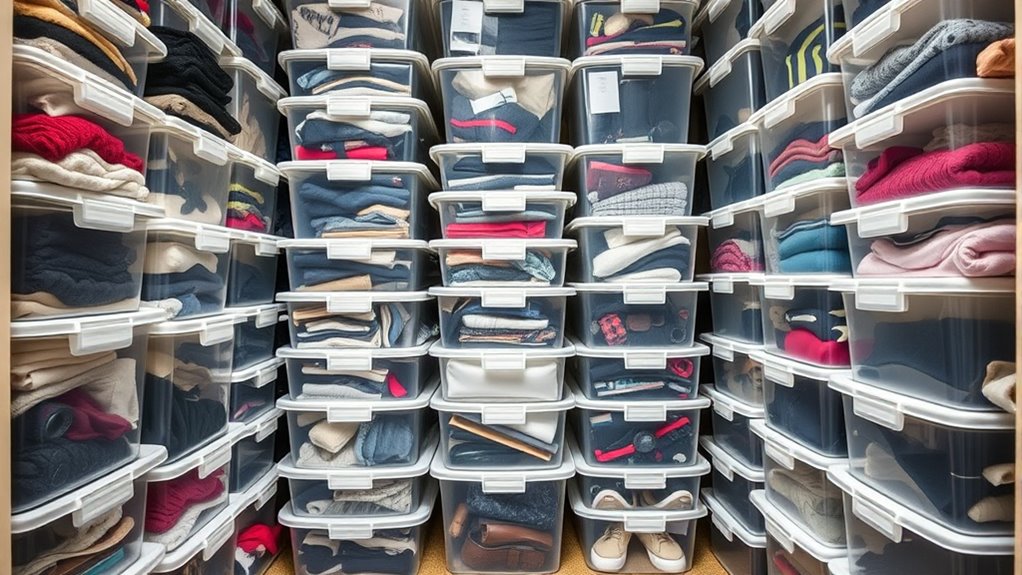
While clear storage bins can make it easy to see what’s inside, overusing them often leads to wasted space. When you rely on too many, you might create labeling clutter, making it harder to find items quickly. Instead of stacking bins randomly, consider color coding to organize similar items visually. This reduces the need to open multiple containers and prevents your shelves from looking cluttered. Overusing clear bins can also create gaps and uneven stacking, wasting valuable space. Be selective about what you store in transparent containers, and label them clearly to avoid confusion. Using fewer, well-organized bins with consistent labeling and color coding helps maximize storage efficiency and keeps your space tidy. Focus on quality organization rather than simply making everything visible. Incorporating vertical storage solutions can further optimize your space by utilizing unused height and reducing clutter.
Filling Shelves to Capacity

Overfilling shelves might seem like a way to maximize storage, but it often leads to clutter and inefficient use of space. When you cram items tightly, it becomes hard to find what you need and can damage fragile objects. Instead, use drawer dividers to organize smaller items within shelves, keeping similar things together and easy to access. Implement a clear label system on shelves and containers to identify contents quickly, reducing the need to pull everything out. Leave some space between items to allow for easy retrieval and avoid crushing or damaging items. Overstuffed shelves may look full, but they’re not functional. By creating designated zones with dividers and labels, you optimize your storage and maintain a tidy, accessible space. Incorporating storage solutions that promote organization can further enhance space utilization and prevent clutter buildup.
Stacking Items Without Accessibility

Have you ever stacked items so high that reaching the ones at the bottom becomes a chore? This common mistake creates accessibility issues, forcing you to unstack everything just to grab something. Not only is this inefficient, but it also risks damaging your belongings. Plus, stacking like this can hide items in hidden compartments, making it easy to forget what’s there. When you force yourself to dig through piles, you waste time and energy. Instead, organize items in a way that keeps everything within easy reach. Use shelves or containers that allow you to see everything at a glance. Avoid stacking too high or deep, and always consider accessibility. Keeping things accessible prevents clutter from becoming a space-wasting maze and saves you from unnecessary hassle. Being aware of grocery store hours can also help streamline your shopping trips and reduce the need to dig through clutter to find what you need.
Using Uniform Containers for Everything

Using uniform containers for everything might seem like a simple solution, but it can lead to new problems if not done thoughtfully. When you choose identical containers for different items, you risk labeling mistakes and container mismatches that hinder your organization. Uniformity can make it harder to distinguish contents quickly, leading to confusion. To avoid this, consider these points:
- Use different sizes or shapes for varied items
- Label containers clearly and specifically
- Avoid forcing all items into the same container type
- Match container lids to their respective bases accurately
- Don’t rely solely on uniformity; prioritize function over appearance
- Incorporating diverse storage solutions can greatly improve space utilization and accessibility.
Balancing uniform containers with varied options allows for better space use and quicker access, preventing organization from becoming a space-wasting mistake.
Ignoring Vertical Space Efficiency
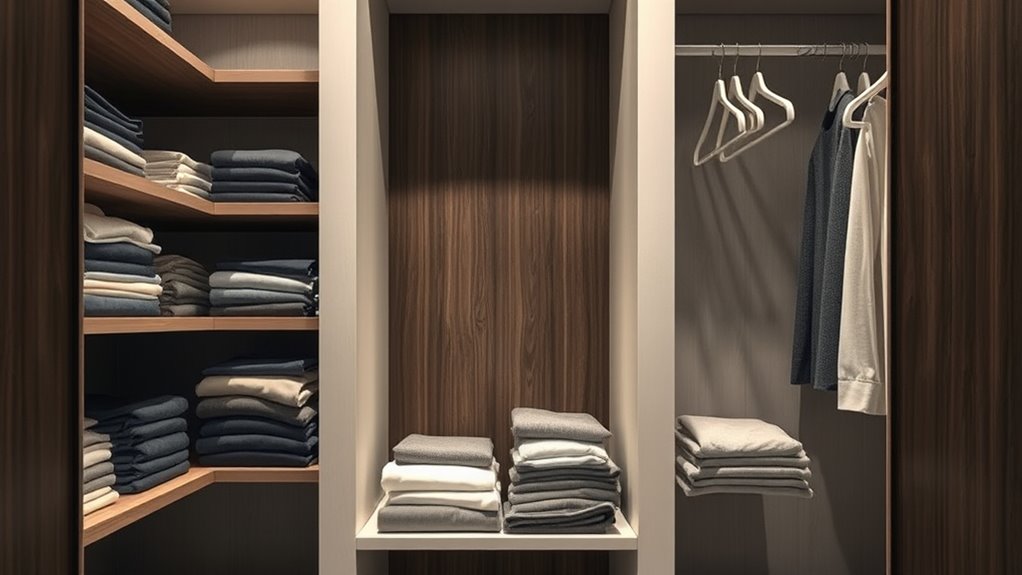
Are you overlooking the potential of vertical space in your storage areas? Many people focus on horizontal organization but neglect the unused wall space above. Vertical stacking allows you to maximize every inch of your room, creating more storage without expanding your footprint. Install shelves or hooks to utilize walls for items like tools, kitchen supplies, or decorative bins. This keeps clutter off surfaces and makes everything more accessible. Ignoring vertical space wastes valuable storage potential and can make areas feel cramped. By simply adding vertical storage solutions, you free up floor space and improve organization. Additionally, understanding city dynamics can help you plan better storage solutions tailored to your living environment. Don’t let unused wall space go to waste—think vertically and transform your cluttered areas into efficient, spacious zones.
Frequently Asked Questions
How Can I Best Balance Visibility and Storage in Small Spaces?
To balance visibility and storage in small spaces, you should use effective labeling strategies and color coding. Label shelves and containers clearly so you can easily find what you need without clutter. Color coding helps you categorize items visually, making it simple to identify contents at a glance. Keep frequently used items within reach, and store less-used things higher or further back to maximize space and maintain a tidy, accessible area.
What Are Alternative Methods to Using Clear Bins for Organization?
You can explore alternative methods like using visual labeling on opaque containers to maintain clarity without clear bins. Modular shelving allows you to customize your storage, making it easy to access and organize items efficiently. This approach maximizes space, enhances visibility, and keeps everything neatly arranged. Combining visual labeling with modular shelving guarantees you find what you need quickly while avoiding the drawbacks of transparent bins.
How Do I Choose the Right Container Size for Different Items?
Oh, the thrill of picking the perfect container size! First, check the container dimensions to match your items precisely. Avoid the trap of oversizing or undersizing, which leads to clutter or damage. Think about item compatibility—are fragile items better in smaller, cushioned containers? Measure accurately, consider how often you access the items, and choose a size that balances space efficiency with ease of use. Happy organizing!
Can Decorative Storage Solutions Improve Space Efficiency?
Decorative bins and aesthetic storage can definitely enhance your space while keeping it organized. They add visual appeal and make it easier to access items, reducing clutter. However, choose sizes that fit your belongings without wasting space. When you select stylish storage solutions thoughtfully, they serve dual purposes—improving your decor and maximizing space efficiency. Just avoid overly decorative options that are too small or large for your needs, which can hinder organization.
What Are Common Mistakes to Avoid When Organizing Vertical Space?
When organizing vertical space, avoid common mistakes like overstacking, which can make items hard to access or cause damage. Also, prevent labeling errors that lead to confusion and clutter. You should use sturdy, well-placed shelves, and clearly label everything for quick identification. Don’t cram too many items into one area, and always consider accessibility. This way, your vertical space remains functional, neat, and easy to maintain.
Conclusion
Stop making these common mistakes before they turn your space into a cluttered mess. Overusing clear storage bins, filling shelves to the brim, stacking without access, or using uniform containers for everything only backfires. Don’t forget, sometimes less is more, and thinking vertically can work wonders. Change your approach now, or you’ll keep digging yourself into a hole. Remember, a little effort today saves you from chaos tomorrow. Get smart with your space and watch it transform!


